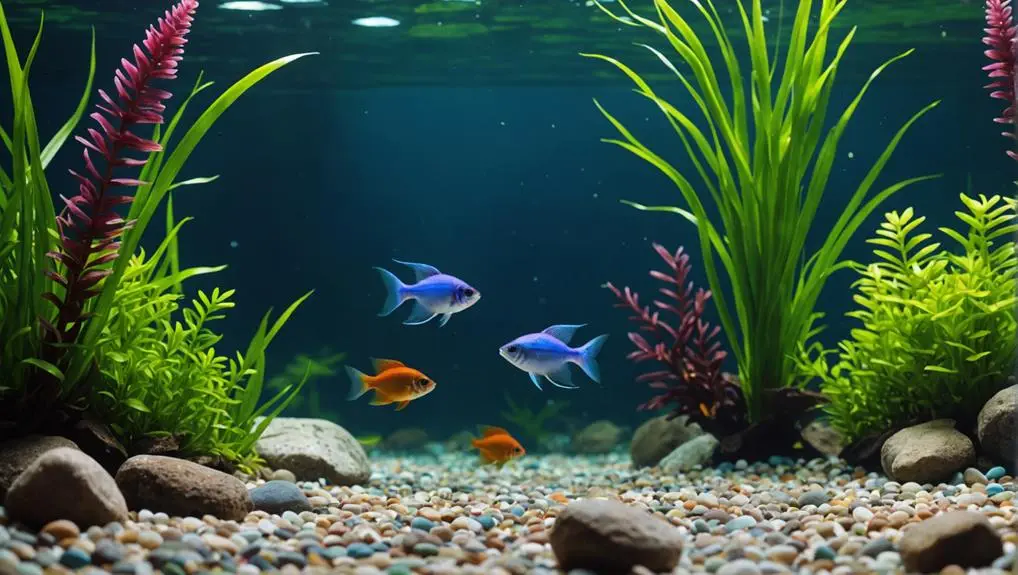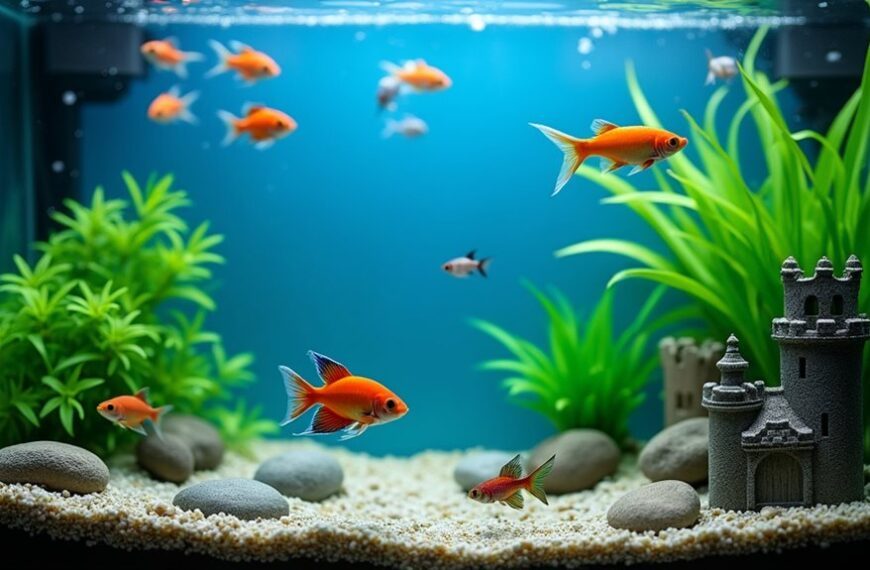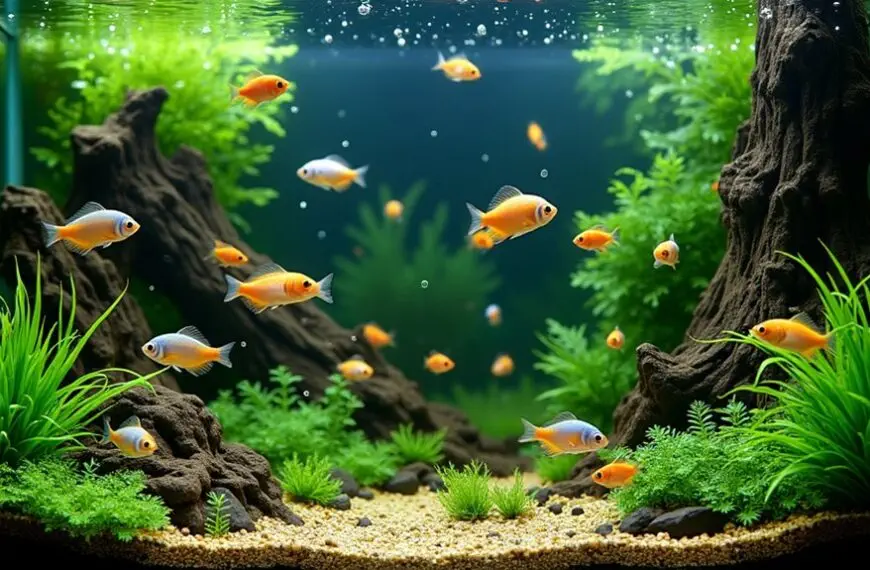When you're starting your aquarium adventure, choosing the right fish can make all the difference. Guppies, platies, and neon tetras are fantastic options for beginners. They're colorful, super adaptable, and thrive in groups, adding life to your tank! If you've got a smaller setup, consider pygmy corydoras or celestial pearl danios; they don't take up much space yet still bring tons of personality. Remember, keeping your fish friends happy means maintaining good water quality and avoiding overcrowding. So, get set to create an underwater world, because there's so much more to explore and learn about your new aquatic pals!
Contents
Best Freshwater Fish Overview
When you're starting out in the world of aquariums, choosing the right fish can make all the difference. You want to set up a community tank that's vibrant and lively, and the best beginner fish can help you achieve just that. Hardy species like guppies, platies, and neon tetras are perfect choices. They thrive in stable water conditions, which is crucial during the cycling process, and are known for their low care requirements.
Establishing a proper cycle in your tank is essential for creating a healthy environment that supports beneficial bacteria to process waste effectively the nitrogen cycle.
Neon tetras, in particular, are active swimmers and love to be in groups. Keeping at least six of them won't only make them feel secure but also add a splash of color to your tank. Plus, their small size means they won't take up too much room in your 10 to 20-gallon setup.
Platies, with their adaptability, grow to about 3 inches, while guppies remain smaller at around 2 inches. And don't forget about Corydoras catfish! These peaceful bottom dwellers enjoy company, so keeping groups of four to six will keep them happy and your tank clean.
With these fantastic fish, you'll create a thriving aquarium that's sure to bring joy to you and others.
Ideal Fish for Small Tanks
Creating a vibrant aquarium doesn't have to mean filling a large tank. If you're a beginner looking to create a cozy little environment, small tanks (5-10 gallons) can be perfect for you.
Choosing the right tank size and fish species is crucial for maintaining a healthy ecosystem, as ideal fish for small tanks include those that thrive in groups and require minimal space.
Consider fish like Neon Tetras and Guppies—both only grow to about 1-2 inches. They're social little creatures that thrive in groups of six or more, making them great community fish.
Pygmy Corydoras are fantastic bottom dwellers, also reaching that 1-2 inch range. They love to hang out in groups, adding a playful vibe to your tank.
If you want something even smaller, Celestial Pearl Danios are just about 1 inch long! They enjoy being in groups too, so don't skimp on their friends.
For more tips on selecting fish, refer to proper tank size and fish species.
Community Fish Recommendations
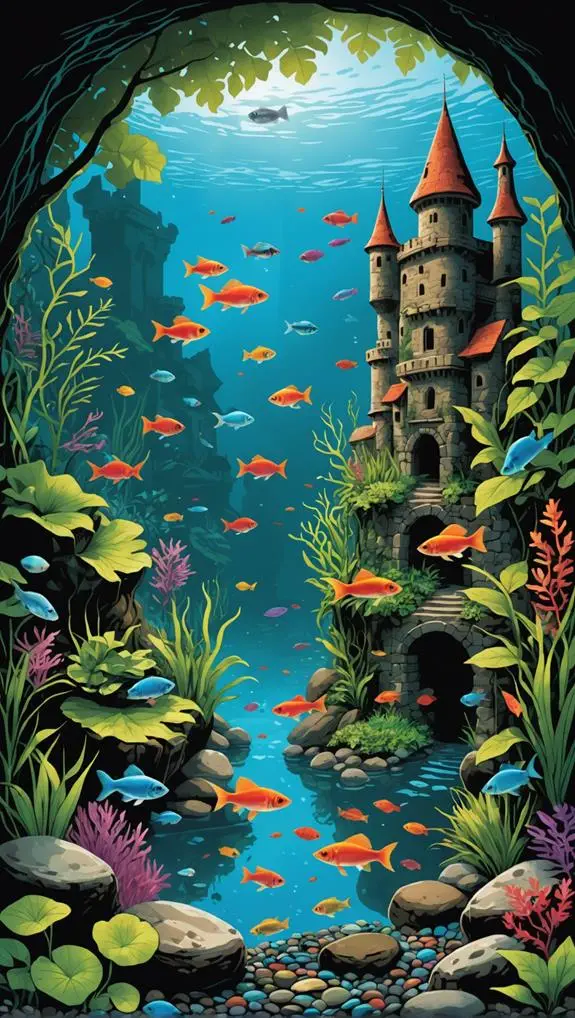
If you're looking to add some lively dynamics to your aquarium, community fish are a fantastic choice. These small fish can bring color and charm to your peaceful aquarium.
Start with neon tetras; their vibrant blue and red colors really pop, and they thrive in schools of at least six. They're like the party-goers of the tank!
Next, consider adding harlequin rasboras. These hardy schooling fish also prefer groups and add a delightful splash of color.
For the bottom of your community aquarium, Corydoras panda catfish are ideal. They're peaceful and social, so don't forget to keep at least six together for their happiness and your tank's cleanliness.
Platies are another easy-to-care option. They adapt well and can be kept in groups, just remember the male-to-female ratio for harmony.
Lastly, guppies are colorful and resilient, making them perfect for beginners. They thrive in small groups and can tolerate various tank conditions.
With these wonderful fish, you'll create a vibrant community that delights both you and your guests. Just imagine the joy of watching them interact!
Schooling Fish Essentials
When it comes to schooling fish, size really does matter—at least in terms of their groups!
You'll want to keep at least six together to help them feel safe and happy, which means more vibrant colors and lively behavior in your tank.
Maintaining high water quality is essential for the well-being of these fish, as it minimizes stress and promotes healthier growth.
Plus, choosing compatible species can turn your aquarium into a bustling community, so let's explore how to make the best choices for your new aquatic friends!
Importance of Group Size
Many new aquarists may not realize the critical role group size plays in the health and behavior of schooling fish. These little swimmers, like tetras and rasboras, thrive best in groups of at least six. When they're in a minimum group size, they feel secure and can display their natural behaviors. If you keep them alone or in too small a group, they may become shy or withdrawn, which isn't fun for anyone!
Having the right group size also helps reduce stress and aggression, creating a vibrant environment in your tank. You'll notice that maintaining proper group sizes enhances the visual dynamics, making your aquarium look lively and inviting. Plus, who doesn't love watching fish swim happily together?
When introducing schooling fish, a gradual introduction is key. This approach helps establish a stable tank community and minimizes territorial disputes.
Think of it as throwing a party — you wouldn't want to invite everyone at once! By focusing on group size, you're not just enhancing their overall health; you're creating a joyful world where they can flourish, bringing smiles to both you and your finned friends.
Happy fishkeeping!
Compatible Species Selection
Choosing compatible species is essential for creating a thriving aquarium. As a new aquarist, you want to ensure that your fish tank is a peaceful community where everyone gets along.
When selecting schooling fish, consider the following:
- Choose Small Species: Opt for small species like neon tetras and guppies. They not only stay small but also bring vibrant colors to your tank without overwhelming it.
- Keep Them in Groups: Schooling fish thrive in groups of at least six. This helps reduce stress and encourages natural behavior, making your aquarium lively and fun.
- Mind the Tank Mates: Avoid mixing peaceful schooling fish with aggressive species like certain barbs or cichlids. You want harmony in your tank, not a fishy soap opera!
Remember to consider each species' adult size and habitat needs.
By carefully selecting compatible tank mates, you'll be well on your way to creating a balanced environment that benefits everyone.
So dive in, and enjoy the journey of building your beautiful community tank!
Your fish will thank you for it, even if they don't have a way to express it!
Hardy Fish for Beginners
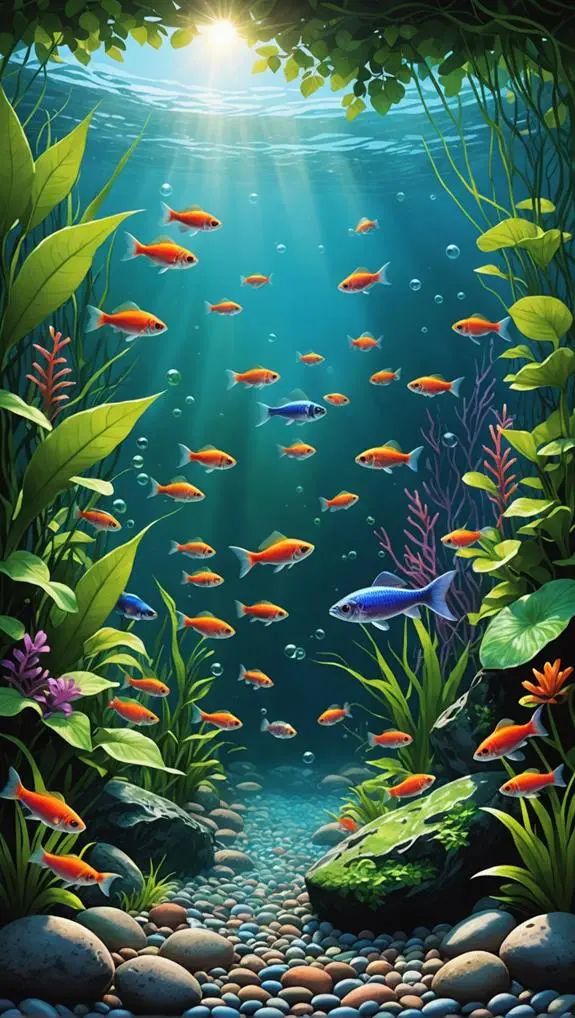
When you're just starting out in the world of fishkeeping, choosing hardy fish can really make your life easier.
Fish like guppies and platies aren't only tough little swimmers, but they also adapt well to various water conditions, so you won't have to stress about perfecting the environment right away.
Plus, adding colorful characters like neon tetras and playful corydoras can make your tank lively and fun, helping you enjoy the journey of being an aquarist!
Ideal Beginner Species
Starting your aquarium journey can be exciting, and picking the right fish is crucial for success. As a beginner, you want hardy species that thrive in community tanks, ensuring a harmonious environment.
Here are three ideal options to consider:
- Betta Fish: These vibrant beauties require a tank size of at least 5 gallons and prefer warm water around 78-80°F. Just remember, they're not the best pals with other males!
- Guppies: Known for their colorful patterns, guppies are adaptable and can live happily in tanks of 10 gallons or more. They're friendly little fish that bring life to your tank.
- Corydoras: These peaceful bottom dwellers, like Panda Corydoras, thrive in groups of six. They prefer a minimum tank size of 10 gallons and get along well with most community fish.
Adding neon tetras and platies to your tank can further enhance the experience.
Neon tetras are schooling fish that love to swim in groups, while platies are resilient livebearers with a friendly nature.
With these options, you'll create a beautiful and lively aquarium that serves both you and your fish!
Resilient Fish Options
Resilient fish options are perfect for beginners looking to build a thriving aquarium. When starting out, you want species that can handle a little turbulence in their new home.
Guppies, for instance, are tiny yet tough, with a maximum size of just 2 inches. They thrive in beginner aquariums of at least 10 gallons, adding a splash of color and personality.
Platies are another fantastic choice, growing to about 3 inches and showcasing their adaptable nature in various conditions.
If you're aiming for community tanks, consider Corydoras catfish. Their peaceful nature and small size make them a joy to watch as they school together.
Neon tetras are like the stars of the show, brightening your tank while being easy to care for. They prefer to swim in groups of six or more, adding vibrancy to any setup.
Cherry barbs, though semi-aggressive, are hardy and can adapt well, making them suitable species for those venturing into beginner aquariums.
Considerations for Tank Setup
Creating a well-thought-out tank setup is crucial for the health and happiness of your freshwater fish.
To give your aquatic friends the best chance at thriving, consider these essential factors:
- Tank Size: Start with a tank size of at least 10 gallons. This helps ensure a stable environment and makes water changes easier.
- Filtration and Heating: Choose a reliable filtration system to keep water quality high, especially for sensitive community fish. A heater is also vital; maintain temperatures around 75-80°F for your beginner-friendly fish.
- Decorations and Substrate: Incorporate various hiding spots and decorations to create a safe space for shy fish. A suitable substrate, like sandy for corydoras or gravel for others, can enhance their comfort.
Maintaining Water Quality

Once your tank setup is established, maintaining water quality becomes a top priority for your freshwater fish.
You want to keep your aquatic friends happy and healthy, right? Regular water changes of 10-20% each week are essential to maintain clean water and remove harmful toxins. It's like giving your fish a refreshing spa day!
Using water test kits, keep an eye on ammonia levels, nitrite levels, and nitrate levels.
Ideally, ammonia and nitrites should be at 0 ppm, while nitrates should stay under 20-40 ppm. Don't forget about pH levels too! Most freshwater fish thrive in a stable pH range of 6.5 to 7.5, so double-check that regularly.
A reliable filtration system is your best friend; it helps improve water circulation and breaks down waste products, keeping your fish environment healthy.
Common Mistakes to Avoid
When setting up your aquarium, it's easy to overlook some crucial aspects that can lead to trouble down the line. As a new aquarist, avoiding these common mistakes can save you a lot of heartache and keep your fish happy and healthy!
1. Overcrowding a tank: It's tempting to fill your tank, but follow the guideline of 1-2 gallons of water per inch of adult fish size.
Think of it as giving your fish their own cozy space!
2. Ignoring compatibility: Don't just pick fish species based on how they look! Research their behavior and ensure they get along in a community tank.
You wouldn't want a party crasher, right?
3. Skipping the nitrogen cycle: Allow your tank to cycle properly before adding fish.
This step prevents dangerous ammonia spikes that can harm your finned friends.
Remember to keep up with regular water changes to maintain water quality, aiming for 10-15% each week or bi-weekly.
And always consider the adult size of the fish before purchasing.
Happy fishkeeping!
Frequently Asked Questions
What Is the Best Fish to Start a Freshwater Aquarium With?
When starting a freshwater aquarium, focus on fish compatibility, tank cycling, and water parameters. Avoid beginner mistakes by ensuring proper equipment essentials and tank maintenance, while considering decoration choices and fish feeding to promote healthy fish disease prevention.
What Is the First Fish to Put in a New Aquarium?
You'd think picking the first fish is easy, but it's not! Start with hardy species that thrive during the cycling process, ensuring fish compatibility and proper care to reduce stress and promote vibrant aquarium life.
Which Aquarium Fish Is Best for Beginners?
When choosing fish for your aquarium, consider easy care species like guppies and tetras. They're colorful options and peaceful species that thrive in small tanks, offering low maintenance and great compatibility for community setups.
What Is the Best Fish to Add to a New Tank?
Picture your new tank, shimmering with potential. For success, start with hardy, compatible species like guppies or rasboras. Monitor water chemistry, respect their social behavior, and avoid beginner mistakes during tank cycling and maintenance.
Final Thoughts
So, there you have it! Picking the right fish for your tank can feel like diving into the deep end, but with a little knowledge, you'll be swimming smoothly in no time. Remember, every fish has its quirks, so take your time to choose what suits your setup best. By following these tips, you'll create a thriving underwater world that's as lively as a carnival. Happy fishkeeping, and may your aquatic adventure be nothing short of spectacular!

